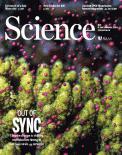The discrepancy between the proton size deduced from the Lamb shift in muonic hydrogen and the average, textbook value based on regular (electronic) hydrogen has puzzled physicists for nearly a decade. One possible resolution could be that electrons interact with protons in a different way than muons do, which would require “new physics.” Bezginov et al. measured the Lamb shift in electronic hydrogen, which allowed for a direct comparison to the Lamb shift measured in muonic hydrogen. The two results agreed, but the discrepancy with the averaged value remains.
Abstract
The surprising discrepancy between results from different methods for measuring the proton charge radius is referred to as the proton radius puzzle. In particular, measurements using electrons seem to lead to a different radius compared with those using muons. Here, a direct measurement of the n = 2 Lamb shift of atomic hydrogen is presented. Our measurement determines the proton radius to be r p = 0.833 femtometers, with an uncertainty of ±0.010 femtometers. This electron-based measurement of r p agrees with that obtained from the analogous muon-based Lamb shift measurement but is not consistent with the larger radius that was obtained from the averaging of previous electron-based measurements.
Read the full article here:
https://science.sciencemag.org/content/365/6457/1007

